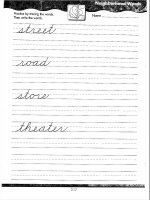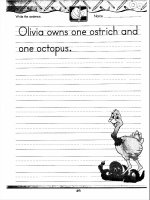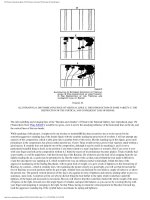Benchmarking the Strategic Management of Technology PHẦN 3 docx
Bạn đang xem bản rút gọn của tài liệu. Xem và tải ngay bản đầy đủ của tài liệu tại đây (359.19 KB, 9 trang )
Appendix:
Survey
Methods
The
Global
Survey
on
the
Strategic
Management
of
Technology
was
developed
by
a
team
headed
by
Professor
Edward
B.
Roberts
of
the
MIT
Sloan
School
of
Management
and
chairman
of
Pugh-Roberts
Associates,
a
division
of
PA
Consulting
Group,
assisted
by
Lauri
Mitchell,
formerly
of
Pugh-Roberts
Associates.
The
staff
of
the
MIT
Industrial
Liaison
Program
(ILP),
directed
by
Thomas
Moebus,
collaborated
closely,
with
coordination
provided
by
Wendy
Elliott.
Several
members
of
the
ILP
Industrial
Advisory
Board
pilot
tested
an
early
draft
version
of
the questionnaire.
Consulting
staff
of
Pugh-Roberts
Associates,
as
well
as
members
of
the
global
technology
management
practice
of
PA
Consulting
Group,
commented
on
various
questionnaire
drafts.
Eric
Wiseman,
previously
of
Pugh-Roberts
Associates,
helped
formulate
the
overall
questionnaire.
Professor
Ralph
Katz
and
Varghese
George
of
the
MIT
Management
of
Technology
and
Innovation
Group
consulted
on
questionnaire
design
and
analyses.
The
two
primary
data
collections
of
the
survey
are:
Benchmarking,
comprising
about
three-fourths
of
the
questions,
to
establish
measures
of
practice
in
global
strategic
management
of
technology,
as
well
as
measures
of
R&D
and
overall
company
performance;
and
the
Special
Research
Topic
(for
this
initial
survey):
Managing
Technology
with
Constrained
Resources,
to
document
worldwide
responses
to
the
changing
economic
climate
in
terms
of
recent,
current,
and
expected
actions
affecting
technical
programs,
staffing,
resources,
and
controls.
The
survey
was
sent
during
1992
to
those
firms
performing
the
largest
amount
of
research
and
development
work
(as
measured
by
their
1991
expenditures)
in
Western
Europe,
Japan,
and
North
America.
The
list
of
companies
sampled
was
determined
from
many
sources
(including
the
U.S.
National
Science
Foundation,
Business
Week,
and
Inside
R&D)
by
starting
with
the
largest
R&D
spender
in
North
America
and
including
all
North
American
firms
in
order
of
decreasing
expenditures
until
the
cumulative
amount
exceeded
80%
of
the
total
R&D
performed
in
this
region.
This
generated
109
firms,
one
headquartered
in
Canada
and
the
rest
in
the
United
States,
all
spending
more
than
$100
million
on
R&D
during
1991.
Using
$100
million
as
the
lower
limit,
all
companies
with
R&D
expenditures
at
or
above
that
level
were
included
from
Western
European
countries
(including
Scandinavia),
producing
80
companies,
and
Japan,
with
55
firms.
The
resulting
sample
of
244
firms
therefore
accounts
for
approximately
80%
of
the
R&D
performed
in
Western
Europe,
Japan,
and
North
America.
The
11
page
English-language
questionnaire
was
mailed
to
the
highest
ranking
technology-related
officer
of
each
company,
followed
later
by
reminder
letters
and
telephone
calls.
Replies
were
mailed
to
the
MIT
Industrial
Liaison
Program,
recorded
in a
master
file
and
assigned
a
code
number
by
that
office,
with
all
company-identifying
information
removed
from
the
questionnaire.
The
resulting
anonymous
questionnaires
were
then
turned
over
to
Pugh-Roberts
Associates
for
comprehensive
data
coding
and
analyses,
producing
a
database
17
that
permits
sorting
by
principal
industry
and
geographic
location
of
corporate
headquarters.
Of
the
244
companies
sampled,
useable
responses
were
received
from
95
firms,
or
39
percent.
46
were
from
the
United
States
(42
percent
response),
27
from
Europe
(34
percent),
and
22
from
Japan
(40
percent),
providing
an
essentially
balanced
response
by
geographic
area,
with
slight
underrepresentation
of
European
companies.
To
further
rule
out
apparent
self-selection
biases,
demographic
comparisons
were
made
of
the
respondents
versus
the
survey
population
in
terms
of
R&D
spending.
Frequency
analyses
in
terms
of
overall
spending
amounts,
as
well
as
cumulative
spending
analyses
for
all
respondents
versus
the
survey
population,
demonstrate
that
the
size
distribution
of
respondents
matches
almost
precisely
with
the
size
distribution
of
companies
surveyed,
for
the
overall
global
sample
as
well
as
for
each
of
the
three
geographic
areas.
The
statistical
analyses
of
the
data
discussed
in
this article
were
carried
out
at
Pugh-Roberts
Associates
by
the
team
of
Lauri
Mitchell,
Mark
Bamford,
and
Edward
Roberts.
18
0
0
0
(
It
cj
4*
cn
o
19
E
O
_-
0
W]a-
0
)
-J
2 iF
m
DE
cu
Q
o
o oa
ctKc
o C
U
Ct
ct
o
o
e-
_
C
C:
10
o
0r
C)
C C a i)
O
4n
a
*
° 4
CS
0)
r
a
EL
a)
zE
Q
CZ
a)
z E
0
ammmmmn
0
O:
Jj
E
c
t
S
v
c
a
o.
o
=
o)
~O
*i >
cl
o'l*
5F
Ld
T
>-;
=
*
-e
;L
=
5
Q
C
o
O
E
a)
x
w
L0
cn
,-
a)
C:
o
0
0
a
CL
0
0
r
a)
u',
. C
0
a)
r
a)
C0Z
o
0
E
a
._
0(
o
a)
cn
(C
2i
20
o
0
c)
0
N.
0
L
I I~~~~~~~~~~
>-
0
o
0
C
0
o
ct
o
o
o
c0
0,-
a
o~
0
-r 0
-~
)
-
c)
)L
kO
o
0
0o
aj=
,'
0
O
c
a
o
c
(
0
o04
*1
0
.
S:
^
*-
L
* 5
*o Un
b
u: E
tZ
)
CD
C
._
r.
m
I
._
O.
5
C
0
E
0
.
0
21
TV
E
0
a)
0
LL
3T
U]
C
0
co
CD
(0
0
!~~~~~~~~~~~~~~~~~~
I
!
4~
0
c,
~C
W~~~~~~~~~~
~~C L~
44
c
.
o
1
)
o
=
Z
C
- - " A
z
o
o
U-
C)
w
0D
CL
w
0
O
L.
C-
0
U-
I
u-
,)
o C/
OL
u
E
Eo
.
,clo
a
,
0
c) o
0)
0
> ~.Ca
C~Itlo0
;
L
"
C C). M
0
~ ~
~
~
~~~~~~TV
0
-
L0Ž>
-
Cj0
L. C) j
-
40)
>
)) %
(::)
I 1 ;o.)
>
CY
c
v'
.
= w- Q
'
vu
o
0
w
,
r
o
-=
Q'
C
0
FX f) I-
-1 n
-
0
0
H>
C
.
_
.
_
1
W.
=
.
W(
.
-
,~
,
rarxr
0
LL
0
C-
>
VV
0 0 0 0
0
22
-
[
a
t
-4
.4
U
. -
:
0
C
o,,
E
!; r
C
"-
C
,
-
aJ
a
,,
>,
U~t
·-
4
2.)
U
U 0:
> ci~~
M
.
C~
~. tCa
.
_)
_ ct a
c
0
0
o
.
0
u-
(.
-ceU
>
~m
.2 C
0,
)
U
_
c
C,3
-W
0
C
_i
O
e
·
II /~1
z
O-
°
*
:
Irs
-
UM
v#~~~~~~~~~~~~~~a
cj
r
I=
-C
·
-
U
U
m
.0 n- r·
+-, U
4
.,
u-:;
I
. -
C-
it;0
-1
Le
._ 1
_
_:
I
I
I
o
0
0
0
0
0
O0
o
o
c\
0o
cr,
d
c
23
r)
cn
CL
r'
06
tr
;0-4
a
;.o
c
*.a
cr
0
V5
tjD
w
.P.
pz
wE
C)
00
.
_o
oao,
©
o
og
~
.
X
o
X
c-'3
.
o =
o ,,,,,
o
.,,.,
Qa)
)
o
Ck c)
s
o
t
3
::
O 4
X
o
O
o :
4_
O
a
O
Ct
. =
L;C
>L
·
O
2
CtQ
O
c ¢N
c0
0
X
~-'.
o ~
~
'"
~.~
C:L-
c
O
s
.
5z
a)
0·2
-
'm
c~
'm'
'
*4Z
nc
o
4Z~
ct
=~~~~~~,
o
Uf
5
Ct
>~~
>,
o
O
C
O ed
'
_O
c
v _ 5
0 0 0
(L
0f
v?
'
0
-
-
C/
0e
~
a
a
M
-o0
. v
w
o
su
5
z
C
U
V4
a)
CL4
0-
c
C,
0
a
)
E
"0
a
;~4
0
0
ct
U
to
:
C)
9-·(
.
24
.X -::
-
" )
C
->
ct
o
Q
c
4::
0
o
E-
;
o
OL.
c
*
W0
o
-
;>
r
,:
o
o
a~
O
0
o0
U
avO
c-
a
4
:;
~
oc
cu
~c~
)
b1
O
, c:
r=
.=;
o
I=
O
=
O~
C
U0
a)
E
Co
o
01)
L.
m
E
o
O
OS
r=
m-
CO
0-
a)
E
z
a)
a
o
LL
(-
25
V
o0
O
O
O
O
O
o
co
(O
lt
c
11
o
I









